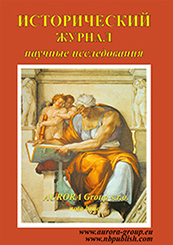History of science and technology
Reference:
Timofeeva, R.A., Chumak, R.N. (2025). Experience in attracting foreign specialists for the design of automatic firearms in the Russian Empire in 1900Ц1901: the machine rifle of Baron A. Odkolek. History magazine - researches, 2, 1Ц19. https://doi.org/10.7256/2454-0609.2025.2.73846
Abstract:
The subject of this article is the development of manual automatic weapons in Russia (the turn of the 19th and 20th centuries) Ц the selection and refinement of design and compositional solutions. The level of sophistication of the arm's designs of this period did not allow for their mass production and operation. This situation had several objective reasons. Firstly, there was a lack of specialized design bureaus and experienced designers with experience in working with automatic weapons in the 1900s to 1910s. Nevertheless, efforts by the Main Artillery Administration led to a series of initiatives aimed at providing the army with modern weaponry. Foreign inventors were engaged, and factories, including the Sestroretsk Arms Factory, became centers for creating new types of firearms. Overall supervision of the work on new weapons was carried out by the GAU (in a rather general manner), so the level of sophistication of the created sample depended on the talent of the inventor. The following research methods were used: historical-scientific analysis of special literature, comparative-historical method, processing of archival data from the funds of state and departmental archives (Central State Historical Archive of St. Petersburg, Scientific Archive of the Military Academy of the General Staff of the Armed Forces of Russia). To study the sample of the "machine gun-rifle" Ц a construction characteristic was compiled through disassembly, examination of the structure and functioning of parts and mechanisms. The scientific novelty is due to the generalization of previously unpublished documentary materials, introducing into scientific circulation one of the few surviving experimental samples from the specified period Ц the "machine gun-rifle" designed in 1900-1901. The identification of such items in itself is a challenging task due to the absence of a unified established terminology in sources from the 1900s. Thus, based on newly discovered archival materials and the study of the preserved sample, it is concluded that the experience of developing A. Odkolek's machine gun in Russia with the participation of specialists from the Sestroretsk Arms Factory could have had a positive impact on the development of domestic engineering personnel for arms manufacturers, particularly in the context of designing automatic rifles in the 1900s to 1910s. During this period, Russia began to form its own, original, and independent design school for automatic weapons, free from direct foreign involvement.
Keywords:
Sestroretsk Arms Factory, archival research, light machine gun, Adolf Odkolek, attribution, machine gun, weapons design, Main Artillery Directorate, automatic weapons, weapons
History of science and technology
Reference:
Filippova, T.P. (2025). The role of science in the development of mineral resources of the European North of the USSR in the context of industrialization. History magazine - researches, 2, 20Ц33. https://doi.org/10.7256/2454-0609.2025.2.73584
Abstract:
The article highlights the historical role of Russian science in the study of the northern and Arctic territories. The object of the study is the process of developing the mineral resource potential of the European North of the USSR in the context of the implementation of the tasks of industrialization in the 1920s and 1930s. This period is characterized by the intensification of research in these territories, when the Soviet government embarked on a course to intensify the industrial development of the Far North and the Arctic, with the aim of quickly involving their rich resource potential in the country's economy. The subject of the research is the historical role of science in the field of prospecting and studying the mineral resources of the European North of the USSR and the importance of the results obtained for scientific and technical support for the development of the mining industry in the region. Based on archival and published sources, the author analyzes the key research results of the USSR Academy of Sciences, the Leningrad Geological Exploration Trust, the All-Union Arctic Institute, the structures of the Main Directorate of Correctional Labor Camps in the territories of the Kola Peninsula, Karelia, the Pechora River basin, the Novaya Zemlya Archipelago, and the Vaigach Island. The methodological basis of the work is based on the basic principles of modern historical science: historicism and scientific objectivity. The research is based on a systematic approach, which made it possible to create an objective historical reconstruction of events related to the discovery and exploration of the mineral resources of the European North during the designated time period. † It is determined that the solution of large-scale state tasks for the scientific and technological development of the country during the period of industrialization necessitated the widespread use of the rich mineral resources of this territory in the development of the USSR economy, which determined the increase in the pace of scientific research activities. As a result, scientists studied a significant part of the European North of the USSR, discovered and explored a large number of mineral deposits of industrial importance (pegmatites, apatite-nepheline ores, coal, oil, etc.). It was concluded that by the end of the 1930s. the identified deposits and detailed geological exploration provided a powerful raw material base for the development of mining industrial development in the territory of the European North of the USSR, which formed one of the foundations of the country's industrial development.
Keywords:
Academy of Sciences of the USSR, national economic planning, industrial development, Geological Committee, industrialization, scientific research, the European North of the USSR, Leningrad Geological Exploration Trust, mineral resources, All-Union Arctic Institute
CULTURAL HERITAGE - HISTORICAL AND CULTURAL ARTEFACTS
Reference:
Gasanov, A. (2025). Virtual 3D-reconstruction of key buildings of the Baranchinsky plant in the Perm Province at the turn of the 19th-20th centuries (source studies and technological aspects). History magazine - researches, 2, 34Ц53. https://doi.org/10.7256/2454-0609.2025.2.73752
Abstract:
This article is dedicated to the process of virtual 3D reconstruction of the manufacturing complex of the Barancha plant in the Perm region, with the turn of the 19th-20th centuries chosen as the time period for reconstruction, representing the peak of the enterprise's development and the most documented period. The architectural design of the blast furnaces, executed by architect A.Z. Komarov, is an outstanding and unique example of Ural industrial architecture. The history of the plant is associated with the names of V.N. Demidov and P.I. Shuvалов, and it was visited by an expedition led by D.I. Mendeleev. The Barancha plant was built in 1743, and its long history included periods of prosperity and decline, while its unique architecture, influenced by the characteristics of the region and the time period, makes the plant an interesting subject for virtual reconstruction. The main aspects under consideration are the work with historical sources in the context of virtual reconstruction of cultural and industrial heritage, particularly the methods of virtual 3D reconstruction, and the issues of selecting and applying software. The novelty of the work lies in the approach to industrial heritage within the field of virtual 3D reconstruction, as well as the scale of the reconstructed object, which consists of an entire complex of buildings, summarizing the experience of working with sources and software in the development of virtual 3D reconstructions. Currently, most historical buildings of the Barancha plant have been destroyed, which makes the choice of it as an object for reconstruction particularly relevant. The work presents images of several sources depicting the visual appearance of the plant, supported by their descriptions and classifications, screenshots of the reconstruction process demonstrating the technical solutions employed, as well as final visualizations (renders) of the complex of buildings that were the subject of virtual reconstruction. All work on the virtual 3D reconstruction was carried out using free software Ц the 3D editor Blender.
Keywords:
Baranchinsky Ironworks Plant, Ural industry, Blender, history IT, 3D-modeling, virtual 3D-reconstruction, cultural heritage, Industrial heritage, source study, scientific and technical documentation
 This work is licensed under a Creative Commons Attribution-NonCommercial 4.0 International License.
This work is licensed under a Creative Commons Attribution-NonCommercial 4.0 International License.
 Eng
Eng












 © 1998 Ц 2025 Nota Bene. Publishing Technologies. NB-Media Ltd.
© 1998 Ц 2025 Nota Bene. Publishing Technologies. NB-Media Ltd.




